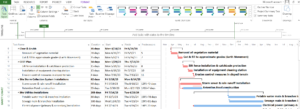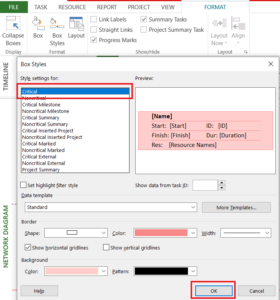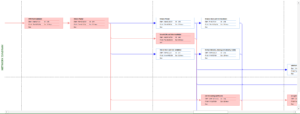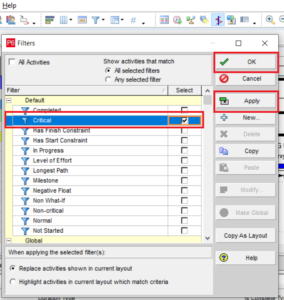The success of any project depends on effective planning and execution. Project managers and Schedulers use different techniques and tools to ensure that their projects are completed on time and within budget. One of the most popular project management techniques is the Critical Path Method (CPM). In this blog post, we will explore the concept of the Critical Path Method and how it is used in project management, and how it can be found through MS project and Primavera P6.
What is the Critical Path Method?
The Critical Path Method (CPM) is a project management technique used to identify the most important tasks in a project and the order in which they must be completed. It helps project managers and schedulers to determine the minimum amount of time required to complete a project and identify the tasks that can be delayed without affecting the overall project completion date.
The CPM is based on the principle that a project is made up of a series of tasks that are interdependent. Some tasks must be completed before others can begin, and some tasks can be done concurrently. The CPM helps project managers to identify the sequence of tasks and their dependencies.
How is the Critical Path Calculated?
The Critical Path is the sequence of tasks that must be completed on time to ensure that the project is completed on schedule. It is calculated by identifying the tasks that have zero slack time or float. Slack time is the amount of time that a task can be delayed without affecting the overall project completion date.
To calculate the Critical Path, project managers need to follow these steps:
- Identify all the tasks required to complete the project
- Determine the duration of each task
- Identify the dependencies between the tasks
- Determine the earliest start time and the earliest finish time for each task
- Determine the latest start time and the latest finish time for each task
- Calculate the slack time for each task by subtracting the earliest start time from the latest start time
- Identify the tasks with zero slack time
- Finally, The sequence of tasks with zero slack time is the Critical Path
It means CPM helps project managers to identify the tasks that are critical to the project’s success and allocate resources accordingly. Project managers can also use the CPM to identify the tasks that can be delayed without affecting the project completion date.
Project managers can use different software tools also to implement the CPM. Microsoft Project is a popular project management tool that has a built-in feature to calculate the Critical Path. Primavera P6 is another popular project management tool that uses the Critical Path Method to help project managers to plan and execute their projects. There are several other software tools like Asana, which help in determining the Critical Path Method, but MS Project and Primavera P6 are widely used among Construction projects.
How to calculate Critical Path through MS Project?
Microsoft Project is one of the famous software tools that can help project managers to calculate and analyze the Critical Path. Microsoft Project has a built-in feature to calculate the Critical Path.
To calculate the Critical Path in Microsoft Project, project managers or schedulers need to follow these steps:
- Create a new project or open an existing project in Microsoft Project.
- Define the tasks required to complete the project and their dependencies.
- Enter the duration of each task.
- Define the start and finish dates of the project.
- Click on the “View” tab in the Ribbon and select “Gantt Chart.”

6. Click on the “Format” tab in the Ribbon and select “Critical Tasks.”

7. The Critical Path will be displayed in red on the Gantt Chart.

How to Identify the Critical Path using Microsoft Project?
In addition to calculating the Critical Path, project managers can use Microsoft Project to identify the Critical Path and analyze the impact of changes to the project schedule. To identify the Critical Path using Microsoft Project, project managers need to follow these steps:
- Open the project schedule in Microsoft Project.
- Click on the “View” tab in the Ribbon and select “Network Diagram.”

3. Click on the “Format” tab in the Ribbon and select “Layout.”

4. Under “Box Layout,” select “Critical Tasks” and click “OK.”

5. The Critical Path will be displayed in red on the Network Diagram.

By following the steps mentioned above, project managers and schedulers can use Microsoft Project to effectively plan and manage their projects, ensuring that they are delivered on time and within budget.
How to calculate Critical Path through Primavera P6?
One of the key features of Primavera P6 is its ability to calculate and display the Critical Path of a project.
Primavera P6, is by default showing Critical path as red color in Gantt Chart. But if you are unable to find Critical Path, then follow these steps:
- Create a new project or open an existing project in Primavera P6.
- Define the tasks required to complete the project and their dependencies.
- Enter the duration of each task.
- Define the start and finish dates of the project.
- Click on the “Activities” tab and ‘’Schedule’’ (F9) it.
- Click on “Gantt Chart.”
- Apply Filters, by selecting ‘’Critical’’, then click on ‘’Apply’’ and ‘’Ok’’.

8. The Critical Path will be displayed in red on the Gantt Chart.

How to Identify the Critical Path in Primavera P6?
In addition to calculating the Critical Path, project managers can use Primavera P6 to identify the Critical Path and analyze the impact of changes to the project schedule. To identify the Critical Path using Primavera P6, project managers need to follow these steps:
- Open the project schedule in Primavera P6.
- Click on the “Activities” tab and select “Schedule.”
- Click on “Layout” and select “Network Diagram.”
- Click on “Group and Sort” and select “By Critical Path.”
- The Critical Path will be displayed in red on the Network Diagram.
Conclusion:
The Critical Path Method (CPM) is a project management technique used to identify the most critical tasks in a project and the order in which they must be completed. By using the CPM, project managers, and schedulers can determine the minimum amount of time required to complete a project and allocate resources accordingly. MS Project and Primavera P6 are two popular software tools that project managers can use to calculate and analyze the Critical Path.
To calculate the Critical Path using MS Project or Primavera P6, project managers need to follow a few simple steps, such as defining tasks, their dependencies, and their durations. Once the Critical Path is calculated, it can be displayed on a Gantt chart or network diagram, making it easier to identify and manage critical tasks. By using MS Project or Primavera P6 to identify the Critical Path, project managers can effectively plan and manage their projects, ensuring that they are completed on time and within budget.
Leopard Project Consultancy is an expert in providing professional project management services for construction, engineering, and infrastructure projects. We provide expert guidance on implementing the Critical Path Method in project management and can help with any CPM-related issues. With our experience and expertise, we can assist you in the effective planning and execution of projects, ensuring that your projects are delivered on time and within budget.





